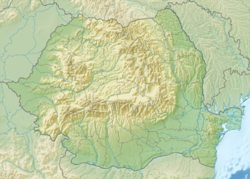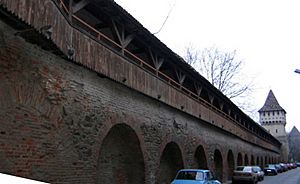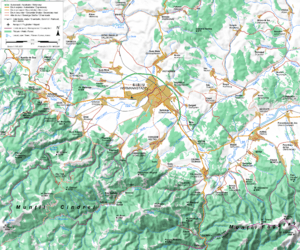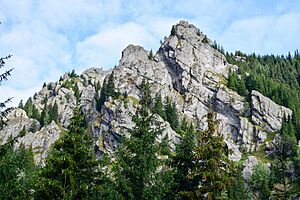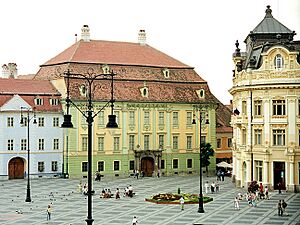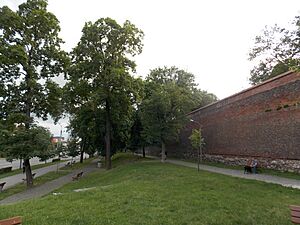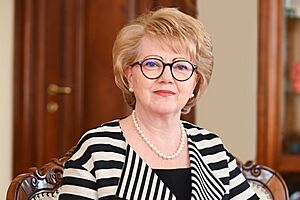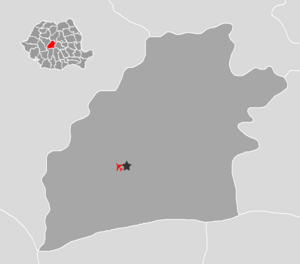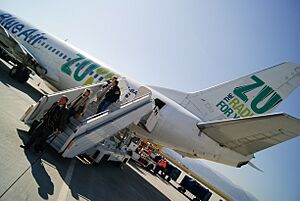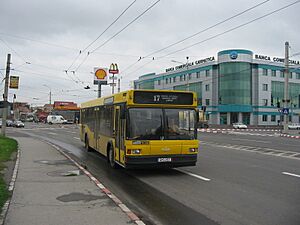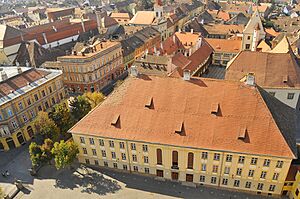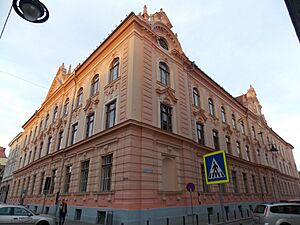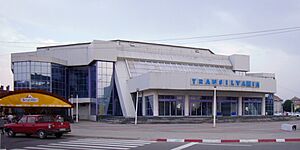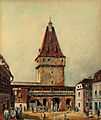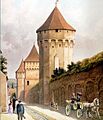Sibiu facts for kids
Quick facts for kids
Sibiu
|
|||
|---|---|---|---|
|
Municipality, former European Capital of Culture in 2007
|
|||
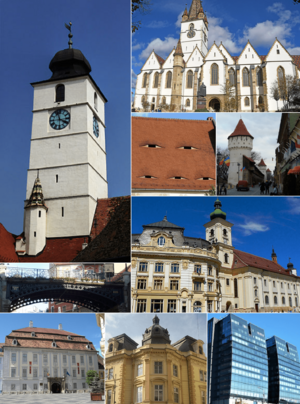
From top, left to right:
Council Tower (town symbol) • Lutheran Cathedral • Eyes of Sibiu • Medieval fortifications • Bridge of Lies • Town hall and Jesuit Church • Brukenthal Palace • Neo-Baroque palace • modern high-rise buildings |
|||
|
|||
| Nickname(s):
The Town with Eyes
|
|||
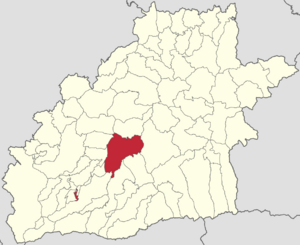
Location in Sibiu County
|
|||
| Country | |||
| County | Sibiu | ||
| Status | County seat | ||
| Settled | 1st century BC | ||
| Resettled | c. 1147 | ||
| First off. record | 1191 (as Cibinium) | ||
| Founded by | Hermann | ||
| Area | |||
| • Municipality, former European Capital of Culture in 2007 | 121 km2 (47 sq mi) | ||
| Elevation | 415 m (1,362 ft) | ||
| Population
(2021 census)
|
|||
| • Municipality, former European Capital of Culture in 2007 | 134,309 | ||
| • Density | 1,110/km2 (2,875/sq mi) | ||
| • Metro
a
|
267,170 | ||
| Demonym(s) | sibian, sibiancă (ro) hermannstädter (de) |
||
| Time zone | UTC+2 (EET) | ||
| • Summer (DST) | UTC+3 (EEST) | ||
| Area code(s) | +40 269/369 | ||
| Car plates | SB | ||
| aSibiu metropolitan area is a proposed project | |||
Sibiu is a historic city in central Romania. It's known for its old, fortified buildings from the Middle Ages. The city is located in the region of Transylvania, about 275 kilometers northwest of Bucharest. It sits by the Cibin River, which flows into the Olt River.
Sibiu was once the capital of the Principality of Transylvania for many years. It's often called The Town with Eyes because many of its old houses have unique roof windows that look like eyes. This makes Sibiu a very popular place for tourists.
The city is famous for its culture, history, and delicious local food. In 2007, Sibiu was chosen as a European Capital of Culture, sharing the title with Luxembourg City. This brought a lot of attention to the city. In 2019, it was also named the European Region of Gastronomy because of its great food scene.
Sibiu is also well-known for its beautiful Christmas market, which was the first of its kind in Romania. Important people from Sibiu include scientists Conrad Haas and Hermann Oberth, who were pioneers in rocket technology.
As of 2021, Sibiu has a population of about 134,309 people. It is the 15th largest city in Romania. The city also manages a nearby ski resort called Păltiniș. Historically, Sibiu was a very important center for the Transylvanian Saxons, a group of Germans who settled in Transylvania.
Contents
What's in a Name?
The name Sibiu comes from an old word, "Sibin," which means "rejoice." In Romanian, it was once called Sibiiu. The Hungarian name for the city is Nagyszeben, meaning "Big Sibiu."
In German, the city is known as Hermannstadt, which means "Hermann's town." This name is also used in the local Transylvanian Saxon dialect, where it's called Härmeschtat. Other languages also have their own names for Sibiu, like Sibiň in Czech and Sybin in Polish.
A Journey Through Time
Sibiu's history goes back a long way. The area might have been home to a Roman fort called Cedonia. The city we know today was founded by German settlers. They were brought here by King of Hungary Géza II in the mid-12th century. These settlers came from parts of Germany, France, and the Benelux countries.
The first time Sibiu was mentioned in official records was in 1191. Back then, it was called Cibinium. Later, in 1223, it was named Villa Hermanni, possibly after a founder named Hermann. The German name Hermannstadt ("Hermann's city") appeared in 1366.
By the 14th century, Sibiu was a busy trading center. In 1376, craftsmen in the city were organized into 19 different guilds. Sibiu became the most important German city among the seven cities that gave Transylvania its German name, Siebenbürgen (meaning "seven citadels").
For a long time, Sibiu was the home of the Transylvanian Saxon University. This was a group of teachers, leaders, and thinkers from the German community. They helped create laws and a political system in Transylvania. In 1699, Sibiu became the capital of the Principality of Transylvania.
During the 18th and 19th centuries, Sibiu also became a very important center for Romanian people in Transylvania. The first Romanian-owned bank, the Albina Bank, was here. Also, the ASTRA association, which promoted Romanian literature and culture, was based in Sibiu.
After World War I, Sibiu became part of Romania. Most of its people were German until 1941. There were also many Romanians and a smaller Hungarian community. After the 1950s, many Germans moved to Germany and Austria.
However, some Transylvanian Saxons stayed. One famous person who remained is Klaus Iohannis. He was the mayor of Sibiu for many years (from 2000 to 2014) before becoming the President of Romania in 2014. The current mayor, Astrid Fodor, also belongs to the German community.
Where is Sibiu?
Sibiu is located almost in the middle of Romania. It sits in a valley called the Cibin Depression. The city is surrounded by beautiful mountains: the Făgăraș Mountains (about 20 km away), the Cibin Mountains (about 12 km away), and the Lotru Mountains (about 15 km away).
The Cibin River and smaller streams flow through Sibiu. Because of its location, Sibiu is a major transportation hub in Romania. Important roads and railway lines pass through the city, including the A1 motorway.
Weather in Sibiu
Sibiu has a humid continental climate. This means it has warm summers and cold winters. The average temperature is about 8 to 9 degrees Celsius. The city gets about 643.7 mm of rain each year. There are also about 120 days of frost annually.
Fun Things to Do in Sibiu
Sibiu is one of the most visited places in Romania. It has many well-preserved medieval buildings and old fortifications. The city's old center started the process to become a UNESCO World Heritage Site in 2004.
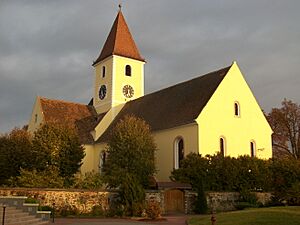
Sibiu has many interesting museums. There are more than 12 museums with collections of art, history, and natural sciences. You can learn about archaeology, traditional folk life, and the history of technology.
The city is also close to the Făgăraș Mountains, which are great for hiking. Nearby are the ski resorts of Păltiniș and Arena Platoș, perfect for winter sports. The area around Sibiu is also famous for its fortified churches, which are old churches built like small fortresses.
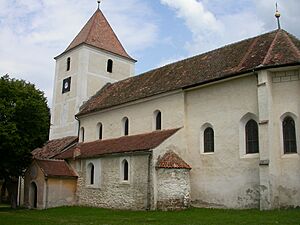
Sibiu's Christmas Market
Since 2007, Sibiu has hosted a traditional Christmas market. It was the first of its kind in Romania and was inspired by the famous markets in Vienna. It started with 38 small stalls and a stage for concerts.
Over the years, the market grew. Now it has about 70 stalls, a bigger stage, an ice skating rink, and a children's workshop. It's a very popular event and was even named one of the "15 Most Beautiful Christmas Markets in Europe" in 2013.
Cultural Events
Sibiu is a very lively city when it comes to culture. It has two main theaters and a philharmonic orchestra. There are also smaller private theaters and a theater studio at Lucian Blaga University.
The Radu Stanca National Theatre is one of Romania's best theaters. It puts on about five shows a week in both Romanian and German. The Gong Theatre specializes in puppet shows and performances for children and teenagers.
The State Philharmonic of Sibiu holds weekly classical music concerts. They also have special educational concerts for kids. These concerts take place in the beautiful Thalia Hall, an old concert hall from 1787.
The Sibiu International Theatre Festival is a huge annual event. Since 2016, it has been the largest performing arts festival in the world.
Museums and Green Spaces
Sibiu's museums are managed by two main groups: the Brukenthal National Museum and the ASTRA National Museum Complex.
- The Brukenthal Museum includes an Art Gallery, an Old Books Library, a History Museum, a Pharmacy Museum (in one of Europe's oldest pharmacies from the 16th century), a Natural History Museum, and a Museum of Arms and Hunting Trophies.
- The ASTRA National Museum Complex focuses on traditional life. It has a large open-air museum in Dumbrava Forest, covering 96 hectares. This museum shows traditional buildings and ways of life. There are also museums about world ethnography and Transylvanian Saxon culture.
The Dumbrava Sibiului Natural Park is a large green area about 4 km from the city center. Here you can find the Zoological Garden (zoo) and the Ethnography Museum. There's also a Steam Locomotives Museum near the railway station, with about 40 old steam engines.
Sibiu has many beautiful parks. The first park, The Promenade, was created in 1791. The Sub Arini Park, built in the mid-1800s, is one of the biggest and best-kept parks in Romania. Other parks include Astra Park, Tineretului Park, and Citadel Park.
Festivals and Events
Many festivals happen in Sibiu every year. The most famous is the Sibiu International Theatre Festival in May. There's also a Medieval Festival in August, which brings the spirit of the Middle Ages back to life.
Other festivals include the Artmania Festival (for rock music), the oldest Jazz Festival in Romania, and the "Astra Film" documentary film festival. Sibiu also hosts Feeric Fashion Week. In 2019, Sibiu was part of the European Regions of Gastronomy program, promoting the region's food and traditions.
How Sibiu is Governed
The city of Sibiu is led by a mayor. Since 2014, Astrid Fodor has been the mayor. She took over from Klaus Iohannis, who became the President of Romania. Klaus Iohannis was mayor for 14 years, even though Germans are a small part of Sibiu's population today.
Decisions for the city are made by the local government, called the Consiliu local. This council has 23 elected members. Sibiu is also the main city of the Sibiu County.
City Neighborhoods
Sibiu is divided into several neighborhoods. Some of these were once separate villages that became part of the city as it grew. Others were built as the city expanded.
Some of the neighborhoods include:
- Historical center (Upper and Lower Town)
- Broscărie
- Gușterița
- Hipodrom
- Lazaret
- Ștrand
- Terezian
- Turnișor
- Valea Aurie
- Vasile Aaron
The ASTRA National Museum Complex and the Zoo are also within the city limits. The Păltiniș ski resort, located 35 kilometers south, is also managed by Sibiu.
People of Sibiu
At the 2021 census, Sibiu had a population of 134,309 people. Most of the residents are Romanians. There are also smaller communities of Hungarians and Germans (Transylvanian Saxons).
Most people in Sibiu are Romanian Orthodox. Smaller numbers of people belong to Protestant and Roman Catholic faiths.
Sibiu's Economy
Sibiu is an important economic center in Romania. It attracts a lot of foreign investments. Many factories that make car parts are located here, including those belonging to large companies like ThyssenKrupp and Continental Automotive Systems. Other industries include machine parts, textiles, and electrical components.
Tourism is also a very important part of Sibiu's economy. The number of tourists visiting the city has been growing steadily since 2007.
Getting Around Sibiu
Sibiu has good transportation links. In 2010, a city bypass road was opened. This helped reduce traffic inside the city.
Tursib is the company that runs the public transportation system within Sibiu.
By Air
Sibiu International Airport is one of Romania's most modern airports. It has direct flights to countries like Germany, Austria, the United Kingdom, Ireland, and Spain.
By Road
Sibiu is a key point in Europe's road network. Two major European routes, E68 and E81, pass through the city. Nationally, Sibiu is on three main roads: DN1, DN7, and DN14.
The Romanian Motorway A1 will connect Sibiu to other major cities. Sibiu's ring road, which is part of the A1 motorway, was finished in 2010.
Many bus companies also offer connections from Sibiu to other places in Romania and internationally.
By Train
Sibiu is on the main railway lines of CFR-Romanian Railways. The city has five train stations, including the Main Station (Gara Mare) and the Little Station (Gara Mică).
Many trains connect Sibiu to other big Romanian cities like Cluj-Napoca, Brașov, and Bucharest.
By Bicycle
Cycling has become very popular in Sibiu in recent years. The city has 43 kilometers of bicycle lanes. A new bike path is being built along the Cibin River, creating a green route through several neighborhoods. There are also several places to rent bicycles.
Learning in Sibiu
Sibiu is an important center for higher education. It has over 23,000 students attending four public and private universities.
The Lucian Blaga University of Sibiu was founded in 1990. It started with five faculties and now has 10 different departments.
Sibiu is also home to the Nicolae Bălcescu Land Forces Academy and two private universities.
There are 20 high schools in Sibiu. Some of the most important ones include:
- Gheorghe Lazăr National College – focusing on sciences and computer science.
- Samuel von Brukenthal National College – a German language high school.
- Octavian Goga National College – for social sciences, sciences, and languages.
Sports in Sibiu
Sibiu has a football stadium, a multi-functional arena called Sala Transilvania, a rugby court, and a municipal swimming pool.
Several international sports events are held here each year:
- Sibiu Cycling Tour (in July)
- Red Bull Romaniacs Hard Enduro Rallye (a tough motorcycle race)
- Sibiu Rally (a car rally)
Football
Sibiu has a long history with football. The city's best team ever was Inter Sibiu, which won the Balkans Cup in 1990–91. Currently, FC Hermannstadt is the main football team representing Sibiu. They play in Romania's top league, the Superliga. Their home stadium is the rebuilt 13,000-seat Stadionul Municipal Sibiu.
Basketball
CSU Sibiu is one of Romania's best basketball teams. They represent Sibiu in the top Romanian basketball league, Liga Națională.
Handball
The city's handball team is called CSM Sibiu.
Famous People from Sibiu
Many notable people were born or lived in Sibiu, including:
- Klaus Iohannis, the current President of Romania.
- Hermann Oberth, a pioneer in rocket technology.
- Ion Besoiu, a famous Romanian actor.
- Andrei Codrescu, an American writer.
Sibiu's Global Connections
Sibiu has special agreements with other cities around the world, called "twin towns." These agreements help promote cultural exchange and friendship.
Some of Sibiu's twin towns include:
- Bauru, Brazil
- Columbia, Missouri, USA
- Deventer, Netherlands
- Klagenfurt, Austria
- Landshut, Germany
- Rennes, France
- Takayama, Gifu, Japan
Several countries also have consulates in Sibiu, which are offices that help their citizens and promote relations with Romania. These include Germany, Austria, Luxembourg, and Malta.
Images for kids
See also
 In Spanish: Sibiu para niños
In Spanish: Sibiu para niños




